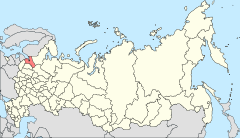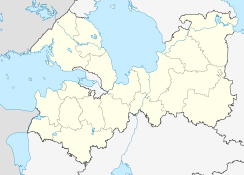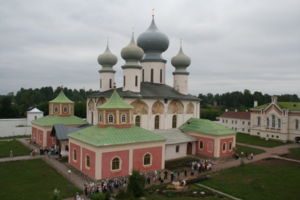- Tikhvin
-
Tikhvin (English)
Тихвин (Russian)- Town[citation needed] - 
View of Karl Marks Street (the longest in Tikhvin)
Location of Leningrad Oblast in RussiaCoordinates: 59°38′N 33°31′E / 59.633°N 33.517°ECoordinates: 59°38′N 33°31′E / 59.633°N 33.517°E Coat of arms Flag Town Day July 9[citation needed] Administrative status Country Russia Federal subject Leningrad Oblast Administrative district Tikhvinsky District[citation needed] Administrative center of Tikhvinsky District[citation needed] Municipal status Head of Administration[citation needed] Konstantin Polnov[citation needed] Statistics Area 24 km2 (9.3 sq mi)[citation needed] Population (2010 Census,
preliminary)58,843 inhabitants[1] - Rank in 2010 281st Population (2002 Census) 63,338 inhabitants[2] - Rank in 2002 254th Density 2,452 /km2 (6,350 /sq mi)[3] Time zone MSD (UTC+04:00)[4] First mentioned 1383[citation needed] Postal code(s) 187550, 187556[citation needed] Dialing code(s) +7 81367[citation needed] Official website Tikhvin (Russian: Ти́хвин) is a town and the administrative center of Tikhvinsky District of Leningrad Oblast, Russia, located on both banks of the Tikhvinka River in the east of the oblast, 200 kilometers (120 mi) east of St. Petersburg. Tikhvin is also an industrial and cultural center of the district, as well as its transportation hub. Population: 58,843 (2010 Census preliminary results);[1] 63,338 (2002 Census);[2] 71,352 (1989 Census).[5]
Contents
Origin of Tikhvin's name
The name of the town originates from a combination of two words from the Veps language: "tikh" and "vin" mean "road" and "market" respectively; i.e., road to the market. The town is located on an ancient commercial river way.
History
The first mention of Tikhvin dates from 1383, when a chronicle reported that a wooden Church of the Dormition was built here. Later, in 1495-1496, Y. K. Saburov, a clerk in the Novgorod Cadastre, mentioned the "...Tikhvin parish and in it, a wooden church..."
Its location at the intersection of trade routes which connected the Volga River with Lake Ladoga and the Baltic Sea ensured its rapid development. At the beginning of the 16th century it was already a widely-known commerce and trade center. In 1507-1515, funded by prince Vasili III of Moscow, on the spot of the burnt wooden church, Dmitry Syrkov of Novgorod constructed the monumental stone Cathedral of Dormition, which stands to this day.
In 1560, by order of Tsar Ivan the Terrible, the Monastery of Dormition was built on the left bank of Tikhvinka river. Management of the construction project was entrusted to Fyodor Syrkov, the son of Dmitri Syrkov. Special importance was placed on the haste of its construction; therefore tsar permitted the use of peasants from twenty rural districts to assist in building it.
In the spring and summer of 1560, the large Monastery of Dormition and the smaller Vvedenskiy convent were simultaneously built, as well as two trade and industrial settlements with various buildings for residential, economic and religious purposes. The monastery was initially surrounded by a stockade of sharpened poles. Later, in the middle the 17th century, it was replaced by two parallel log walls, filled in between with earth and stones. A covered walkway with arrow slits went along the top of walls, and above the walls nine powerful towers were raised. Thus, on the spot of an ancient settlement, an important fortified stronghold was created, which would play a large role in the defense of the north-western borders of Russia.
At the beginning of the 17th century the Russian state underwent a deep internal crisis. During the Swedish-Polish incursion, the Swedes occupied and devastated the region around Novgorod. In 1613, Tikhvin was captured, ransacked and burned. Tradespeople, sheltering behind the fortress walls of the monastery, survived a prolonged siege and numerous attacks before routing the Swedish army. The fight ended with the expulsion of the Swedes from the area, marking the beginning of the liberation of the Novgorod region from Swedish and Polish forces.
Tikhvin blossomed economically during the 17th and 18th centuries. The products of Tikhvin's blacksmiths enjoyed special demand, and they were bought not only in Russian cities, but also abroad. Tikhvin became one of the points for foreign trade in Russia, and Tikhvin's fair was one of the largest in Russia. The bloom in trade and crafts in the 17th century contributed to an increase in the settlement, which grew to a significant size.
Stone buildings were permitted only on the territory of the monastery. In the 16th century, in addition to the cathedral, a stone refectory was built, along with a church dedicated to the birth of the Mother of God in 1581. In 1600, a five-roofed belfry was constructed. An especially intense period of stone construction occurred in the second half of the 17th century, when all the wooden buildings in the monastery were replaced by ones of stone. As a result of these works, a highly artistic ensemble of historical and architectural monuments was created on the territory of the monastery, which is mostly preserved to this day, although in the 18th and 19th centuries some of the cloister buildings underwent reconstruction, which altered their original appearance.
Since their construction in 1560, Tikhvin owed its allegiance to the monastery and convent. In 1723, after a prolonged fight, the inhabitants of Tikhvin were freed from monastery control, and they obtained their own administration, a magistrate who answered to the Novgorod province office. The settlement was not totally separated from the monastery until 1764, after an edict concerning the transfer of the monastery's property to the state. In 1773, Tikhvin was granted town status.
During World War II, Tikhvin was occupied by Nazi troops from November 8, 1941 to December 9, 1941. Due to counterattacks on the part of Soviet forces, it had to be abandoned after one month, but many architectural monuments were destroyed during that time. The re-capture of Tikhvin is considered to have been extremely vital in the execution of the Road of Life during the Siege of Leningrad, thanks to its railroad. It allowed the Soviets to provide much more foodstuffs in comparison to the makeshift land road previously used.
Layout of the town
Today, Tikhvin is divided into two parts: the old town, which preserves the look of a small provincial town, and the new town, consisting of apartment blocks built after World War II in the typical Soviet style, similar to what can be found in any modern Russian town. The majority of the population lives in the new town. The houses and buildings of the old town are mostly wooden; in the center square, which prior to the beginning of the 20th century was the commercial heart of the town, stands a restored cathedral, Savior of the Transfiguration, which is the main church in the town. In addition to the cathedral, a number of remarkable buildings are preserved around the square, including the hotel "Saint Petersburg" (now Sberbank) and the "Guest Court", which was closed for many years after the fall of Communism, but has been completely restored and now functions as a shopping center.
Economy
In Soviet times, the largest employer in Tikhvin was a heavy machine factory, where tractors and defense equipment were manufactured. In its heyday, 20,000 people were employed there. Currently, it is the largest producer of railroad rolling stock and military equipment in the region.
Other industrial enterprises in the town include the manufacturing of furniture for IKEA, a construction company, a wood-chemical plant (producing rosin, resin, turpentine, and other such wood-based chemicals), a meat-packing plant, a dairy plant, a bread factory, and other light enterprises.
Sights
The main architectural and historical sight of town is the Monastery of Dormition, founded in 1560. The monastery is famed for the Theotokos of Tikhvin icon. According to legend, it appeared on the shore of the Tikhvinka river on June 26 (Gregorian July 9) 1383; later at this place the monastery and town would be built.
An additional point of interest is the historical part of the town with old wooden buildings and planning characteristic of the 18th century. The ruins of wooden sluices from the 19th century has been preserved as well; these are the remains of the Tikhvin water ways.
The famous Russian composer, Nikolai Rimsky-Korsakov, was born in Tikhvin. His house has been converted into a museum.
Festivals
- "Tikhvin Lel": begun in 1991, a yearly children's artistic competition and festival of traditional dance associations. In 2000 more than 80 associations from different cities of Russia and countries of the CIS participated, with more than 1000 participants. There are three categories of competition: classical dance, folk dance, and variety dance. Many associations attend the festival several years in a row. Since 1998, players of folk instruments have been able to take part in the competition as soloists, duets, ensembles and orchestras. In 2000, 76 contestants participated in this portion of the festival.
- "September in Tikhvin": an open festival of wind and jazz music that began in 2000 and is organized in part by the Rimsky-Korsakov School of Arts. The festival's aims are to encourage connections between musicians of different countries, train young people with the best examples of world jazz, and raise the level of musical education in art and music schools. Famous jazz musicians and jazz associations from Russia and abroad have participated in the festival throughout the years; participants from other countries have included those from Finland, Denmark, Sweden, and Great Britain. One of the initiators of the festival was the Tikhvin jazz quartet (created in 1994), which has repeatedly represented Tikhvin in festivals in France, Germany, and Finland.
Notable residents
- Nikolai Rimsky-Korsakov (1844–1908), composer
- Voin Rimsky-Korsakov (1822–1871), his brother, naval figure
International relations
Main article: List of twin towns and sister cities in RussiaTwin towns/sister cities
Tikhvin is twinned with:
See also
References
- ^ a b Федеральная служба государственной статистики (Federal State Statistics Service) (2011). "Предварительные итоги Всероссийской переписи населения 2010 года (Preliminary results of the 2010 All-Russian Population Census)" (in Russian). Всероссийская перепись населения 2010 года (All-Russia Population Census of 2010). Federal State Statistics Service. http://www.perepis-2010.ru/results_of_the_census/results-inform.php. Retrieved 2011-04-25.
- ^ a b Федеральная служба государственной статистики (Federal State Statistics Service) (2004-05-21). "Численность населения России, субъектов Российской Федерации в составе федеральных округов, районов, городских поселений, сельских населённых пунктов – районных центров и сельских населённых пунктов с населением 3 тысячи и более человек (Population of Russia, its federal districts, federal subjects, districts, urban localities, rural localities—administrative centers, and rural localities with population of over 3,000)" (in Russian). Всероссийская перепись населения 2002 года (All-Russia Population Census of 2002). Federal State Statistics Service. http://www.perepis2002.ru/ct/doc/1_TOM_01_04.xls. Retrieved 2010-03-23.
- ^ The value of density was calculated automatically by dividing the 2010 Census population by the area specified in the infobox. Please note that this value may not be accurate as the area specified in the infobox does not necessarily correspond to the area of the entity proper or is reported for the same year as the population.
- ^ Правительство Российской Федерации. Постановление №725 от 31 августа 2011 г. «О составе территорий, образующих каждую часовую зону, и порядке исчисления времени в часовых зонах, а также о признании утратившими силу отдельных Постановлений Правительства Российской Федерации». Вступил в силу по истечении 7 дней после дня официального опубликования. Опубликован: "Российская Газета", №197, 6 сентября 2011 г. (Government of the Russian Federation. Resolution #725 of August 31, 2011 On the Composition of the Territories Included into Each Time Zone and on the Procedures of Timekeeping in the Time Zones, as Well as on Abrogation of Several Resolutions of the Government of the Russian Federation. Effective as of after 7 days following the day of the official publication).
- ^ "Всесоюзная перепись населения 1989 г. Численность наличного населения союзных и автономных республик, автономных областей и округов, краёв, областей, районов, городских поселений и сёл-райцентров. (All Union Population Census of 1989. Present population of union and autonomous republics, autonomous oblasts and okrugs, krais, oblasts, districts, urban settlements, and villages serving as district administrative centers.)" (in Russian). Всесоюзная перепись населения 1989 года (All-Union Population Census of 1989). Demoscope Weekly (website of the Institute of Demographics of the State University—Higher School of Economics. 1989. http://demoscope.ru/weekly/ssp/rus89_reg.php. Retrieved 2010-03-23.
External links
Cities and towns in Leningrad Oblast Administrative center: Saint Petersburg (administratively separate)  Boksitogorsk · Gatchina · Ivangorod · Kamennogorsk · Kingisepp · Kirishi · Kirovsk · Kommunar · Lodeynoye Pole · Luga · Lyuban · Nikolskoye · Novaya Ladoga · Otradnoye · Pikalyovo · Podporozhye · Primorsk · Priozersk · Sertolovo · Slantsy · Sosnovy Bor · Svetogorsk · Shlisselburg · Syasstroy · Tikhvin · Tosno · Volosovo · Volkhov · Vsevolozhsk · Vyborg · Vysotsk
Boksitogorsk · Gatchina · Ivangorod · Kamennogorsk · Kingisepp · Kirishi · Kirovsk · Kommunar · Lodeynoye Pole · Luga · Lyuban · Nikolskoye · Novaya Ladoga · Otradnoye · Pikalyovo · Podporozhye · Primorsk · Priozersk · Sertolovo · Slantsy · Sosnovy Bor · Svetogorsk · Shlisselburg · Syasstroy · Tikhvin · Tosno · Volosovo · Volkhov · Vsevolozhsk · Vyborg · Vysotsk
Cities of Military Glory of Russia Arkhangelsk · Belgorod · Bryansk · Dmitrov · Kalach-na-Donu · Kozelsk · Kronstadt · Kursk · Luga · Malgobek · Nalchik · Naro-Fominsk · Oryol · Polyarny · Pskov · Rostov-on-Don · Rzhev · Tikhvin · Tuapse · Tver · Velikiye Luki · Veliky Novgorod · Vladikavkaz · Vladivostok · Volokolamsk · Voronezh · Vyazma · Vyborg · Yelets · Yelnya
Categories:- Cities and towns in Leningrad Oblast
- Cities of Military Glory
Wikimedia Foundation. 2010.




